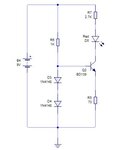andro
Junior Member level 3
Hello
I have this simple current source circuit and the current source through the collector is controlled by voltage drop across the transistor base emitter and resistor R5
Ic=Ie = Vbe/R5
but i want to know how much current flowing through the base and diodes ?
The current flow through the resistor R6 = (9-1.4)/1K = 7.6mA
i supposed the total voltage drop across the diodes = 1.4
but how much current the diodes draw and transistor base for the transistor.
I have this simple current source circuit and the current source through the collector is controlled by voltage drop across the transistor base emitter and resistor R5
Ic=Ie = Vbe/R5
but i want to know how much current flowing through the base and diodes ?
The current flow through the resistor R6 = (9-1.4)/1K = 7.6mA
i supposed the total voltage drop across the diodes = 1.4
but how much current the diodes draw and transistor base for the transistor.
